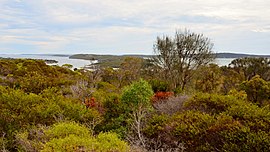Protected area in South Australia
| Kellidie Bay Conservation Park Coffin Bay, Kellidie Bay and Wangary, South Australia | |
|---|---|
| IUCN category Ia (strict nature reserve) | |
 | |
 | |
| Nearest town or city | Coffin Bay |
| Coordinates | 34°36′32″S 135°31′56″E / 34.60889°S 135.53222°E / -34.60889; 135.53222 |
| Established | 30 September 1958 |
| Area | 17.84 km (6.9 sq mi) |
| Managing authorities | Department for Environment and Water |
| See also | Protected areas of South Australia |
Kellidie Bay Conservation Park (formerly the Kellidie Bay National Park) is a protected area in the Australian state of South Australia, located on the west coast of Eyre Peninsula immediately east of the town centre in Coffin Bay and immediately adjoining the south coast of Kellidie Bay in the localities of Coffin Bay, Kellidie Bay and Wangary.
It was reported as being proclaimed as early as 1954 in order ‘to conserve wildlife and the natural and historic features of the land.’ On 9 November 1967, it was proclaimed under the National Parks Act 1966 as the Kellidie Bay National Park. On 27 April 1972, it was reconstituted as Kellidie Bay Conservation Park upon the proclamation of the National Parks and Wildlife Act 1972. As of 2016, it covered an area of 17.84 square kilometres (6.89 sq mi).
In 1980, the conservation park was described as follows:
…consists of low limestone ridges with a cover of black tea tree (Melaleuca lanceolata) and she-oak (Casuarina stricta) woodland. Near the coast there are flat moist areas with much cutting grass (Gahnia spp.). Western grey kangaroos and emus shelter in the high ground and feed on the lower flats. Tiger snakes and Cape Barren geese also occur here.
The following statement of significance was published in 1980:
Kellidie Bay Conservation Park preserves a representative area of Casuarina stricta, Melaleuca lanceolata woodland and Gahnia spp. herbland. It is a very picturesque area and a popular tourist attraction. The uncommon white-breasted sea-eagle and osprey occur here.
The conservation park is classified as an IUCN Category Ia protected area. In 1980, it was listed on the now-defunct Register of the National Estate.
References
- ^ "Terrestrial Protected Areas of South Australia (refer 'DETAIL' tab )". CAPAD 2016. Australian Government, Department of the Environment (DoE). 2016. Retrieved 21 February 2018.
- ^ "Search results for 'Kellidie Bay Conservation Park' with the following datasets selected - 'suburbs and localities', 'Hundreds', 'NPW and Conservation Reserve Boundaries' and 'Gazetteer'". Location SA Map Viewer. Government of South Australia. Retrieved 18 February 2019.
- McEwin, A. Lyell (30 September 1958). "CROWN LANDS AOT, 1929-1944: HUNDRED OF LAKE WANGARY LANDS DEDICATED FOR FLORA AND FAUNA PURPOSES" (PDF). The South Australian Government Gazette. Government of South Australia. p. 843-844. Retrieved 17 February 2019.
Comprising the whole of sections, 1, 2, 3, 4, 5, 6, 7, 8, 9, 10, 11, 12, 13, 21, 131, 271, 273, 274, 275, 276, 277 and 295, hundred of Lake Wangary
- ^ "Protected Areas Information System Reserve List" (PDF). Government of South Australia. 14 December 2016. Retrieved 27 December 2017.
- "No. 56 of 1972 (National Parks and Wildlife Act, 1972)". The South Australian Government Gazette. Government of South Australia: 660 and 700. 27 April 1972. Retrieved 27 February 2018.
- "Parks of the Coffin Bay Area Management Plan" (PDF). Department for Environment and Heritage. 2004. p. 8. Archived from the original (PDF) on 14 July 2015. Retrieved 21 October 2014.
- Walsh, Frank (9 November 1967). "National Parks Act, 1966: Various National Parks Named" (PDF). South Australian Government Gazette. South Australian Government. p. 2043. Retrieved 17 March 2018.
- ^ "Kellidie Bay Conservation Park - listing on the now-defunct Register of the National Estate (Place ID 6698)". Australian Heritage Database. Australian Government. 21 October 1980. Retrieved 1 January 2018.
 This article incorporates text by Commonwealth of Australia available under the CC BY 3.0 AU licence.
This article incorporates text by Commonwealth of Australia available under the CC BY 3.0 AU licence.